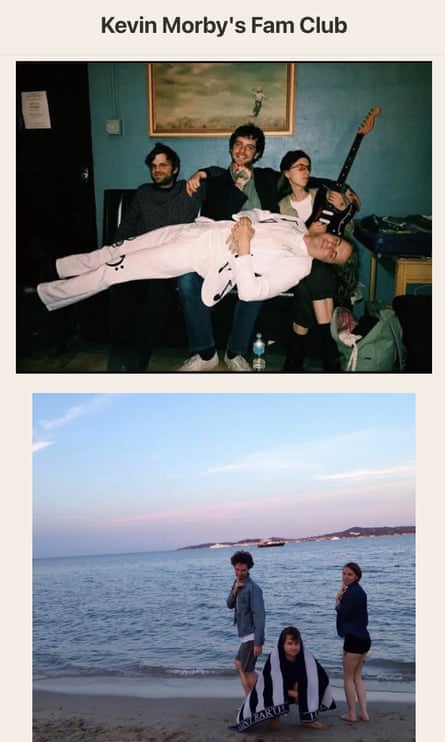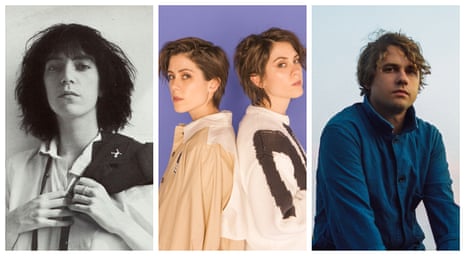“I jumped from my chair and knelt over my father, cradling his head. As if in a movie, I held his head in one hand and snapped the other in front of his face, yelling for him to wake up,” writes singer-songwriter Kevin Morby in a recent post on his Substack newsletter, recounting a night his father had a medical scare. “Thankfully, moments later, his eyes, like cherries in a slot machine, quickly dinged forward and he looked around the room without moving his head.”
Morby loves his Substack. The Kansas City-based musician, who is adored by Pitchfork and recently released his seventh album, This Is a Photograph, joined the email newsletter platform in April at his manager’s suggestion. He now sends his several hundred subscribers a series of rambling, poetic vignettes every few weeks.
He’s not alone. Morby is among a growing number of mostly indie rock artists who’ve joined Substack in the past two years: headliners include Patti Smith, Jeff Tweedy, Perfume Genius’s Mike Hadreas, Neko Case, Tegan and Sara, Thao Nguyen, Incubus’s Brandon Boyd, and The Decemberists’ Colin Malloy.
Each of these musicians now essentially serves as the editor-in-chief of a niche online publication about themselves. The results are a mix of the parasocial and the profound, that highlight the way the internet makes every musician, no matter how small, an influencer.
For between $6/month up to $200/year (nearly all also offer a generous amount of content for free), fans can receive lush descriptions of Patti Smith’s hearty pre-tour breakfasts (“Toast, olive oil, porridge and banana smoothie, side of beans, berries”) as well as chapters of her pandemic novel The Melting..
Tegan and Sara’s newsletter, which has the glossy, soothing energy of the Modern Love podcast, is a series of candid letters between the twin musicians, that serve as a retrospective on their career (the lyrics they fought over, their first big check for a Grey’s Anatomy sync) and their relationship. “We want to cater to people who want to read essays about music and also the people who want to know about Sara’s cats,” says Tegan. “I think we can do both.”
Jeff Tweedy, the 54-year-old frontman of Wilco shares more audio than writing, including demos, covers and drafts of original poems and lyrics. “Substack is a really lovely place to share a work in progress,” he says. “Just, ‘Hey, check this out.’”

Incubus frontman Boyd shares paintings, as well as cerebral diatribes on UFOS and his pandemic break-up. Recently, he wrote a short story about a man in Barcelona who falls in love with a pickpocket. While Neko Case’s posts have a naturalist quality: whimsical essays about magpies and milkweed, that spin off in literary directions.
Perhaps most adventurous is Perfume Genius’s Substack, on which he’s been writing experimental fiction and satire. His entries include an erotic short story about being swallowed alive by the actor Jensen Ackles (“Formed into pure cum energy, I cascaded through his urethra like a great sloshing sea.”) and a sincere review of granola brands (“Too many seeds and ancient grains, would prefer higher oat ratio.”). His entries are so bizarre and skillful they’ve been written up in LitHub.
Hadreas told GQ in October that he had “no idea” his fans would enjoy his writing so much. “I just follow what makes me laugh the hardest or feel the most intensely,” he said, contrasting this to his approach to music, about which he’s “dead serious”.
Musicians deliver albums, music videos and other assets on a strict schedule that leaves little room for experimentation. Simultaneously, the music press that covers these releases has atrophied to just a handful of websites, verticals and full-time journalists, from whom indie bands must scrap for their attention. “No journalist can sit down with me for three hours and get the whole story,” says Tegan. “It’s weird … the digital age has allowed so much access, but it’s very piecemeal. Pieces of the story are everywhere, if you’re a fan you’re gonna have to go out and find the story in a million places. Substack allows us to create a full home for our project.”
Many musicians also seem to crave the freedom to release low-stakes projects without going through a label at all. Hadreas explained in GQ that he started his Substack after beginning to feel stuck in the rut of the album cycle. “I really missed when I would make things just to make them and share them right away and not worry too much about what it means,” he said, remembering when he used to post improvisational sketches on MySpace.
Many have loved the intellectual challenge of leaning into a new form. “It feels like I’m taking a course,” says Morby. Like many writers on Substack, he works with an editor provided (and paid) by the platform. “I have a 10th-grade education, so he’s got a lot of work on his hands when I write.”
The most consistent reason cited for joining Substack among musicians is a growing distaste for the conflict-prone, frenetic culture of Instagram, Twitter and TikTok, where musicians are obligated to be active to promote their music. Artists such as FKA Twigs, Halsey, Florence and the Machine, and Charli XCX have all complained recently about being asked by their labels to post constantly on social media. Many musicians have been craving a calmer way to be online and a more multi-dimensional place to interact with fans.
“I used to really enjoy Twitter and Instagram,” says Morby. “But it feels so manipulative: it’s selling you, rather than you selling yourself. Substack feels like eating a nourishing meal, whereas Instagram and Twitter feel like eating candy bars.”
Unlike the musicians that thrive on TikTok or Instagram, many of Substack’s most adoring musician users are in their 50s or older, like Smith, Case and Tweedy. The platform has become a place for them to convene with older fans. “We have stopped engaging with fans on social media,” says Tegan. “As our audience has aged up, I think they’re excited to rekindle the Tegan and Sara community on Substack.”
Unlike social media, newsletter subscriptions can also be lucrative without having to involve brands or sponsorship deals. Many artists joined in 2021, after touring had been shut down for a full year of lockdown. “I 100% needed the money,” says Case. “It definitely saved my ass. It got me through a period where I thought I might lose my house.”

Morby even predicts that Substack could serve as something like a retirement package for older artists. “When I start slowing down from touring all the time, I can see myself diving into [Substack] as a living more than I do now.” Case agrees: “The rest of my career could easily include Substack. It’s a sidecar that definitely fits on my hog, no question.”
But those long-term plans depend on the viability of Substack as a platform, which is far from certain. In June, the company laid off 14% of its staff, which, alongside the news that Meta put its newsletter product Bulletin on the back burner, prompted Vox to declare that “the newsletter boom is over”. In the past year, a number of high-profile writers – such as Grace Laverty, Jude Doyle, Nick Quah and Charlie Warzel – left Substack either to protest about the brand’s refusal to moderate misinformation or transphobia, or after struggling to meet the demand for content. “And so the internet’s latest shining promise of creative autonomy denatures into another burnout-inducing hamster-wheel game of keep up,” wrote Vanity Fair’s Delia Cai in November.
Many of the musicians on the platform are in a slightly less precarious position because they were brought on board by Substack’s head of writer partnerships Dan Stone, who personally recruited many of the musicians in this article. Stone, the former editor of the music magazine Radio Silence, had the resources to make sitting down and writing worth their while. The average Substack user makes money off subscriptions (they keep 90% and Substack takes 10%). A select few receive advances called “fellowships”, “grants” or their notorious “pro” deals as well as resources such as editing, graphic design and legal services (in exchange, Substack takes the majority of their subscription revenue).
Substack has been criticized for a lack of transparency around who receives these kinds of deals and resources and been accused of offering them to reactionary or conservative writers. Many of the musicians on Substack – at least Smith, Nguyen, Case and Tegan and Sara – received advances upon joining.
And while Substack’s future may be uncertain, it’s still offering more generous terms than music streamers. When Case learned how much the site wanted to pay her, she was in disbelief. “It was like, ‘What? You want to pay a musician for something?’ This doesn’t happen. People like Spotify are always trying to weasel you out of your money.”
In this sense, musicians joining Substack isn’t so much a result of the pandemic, as the pre-existing precarity of the music industry. “The big mythology of the music business is: you’re lucky to be here,” says Case. “It keeps everybody in a stranglehold. But you’re not lucky to be here. You worked to be here.”
Substack is not the only alternative revenue source for musicians unhappy with streaming revenues alone. Ben Folds, Jacob Collier, Zola Jesus and Charly Bliss are all on Patreon, where fans pay $5-25/month for access to them on Discord channels, livestreams and Zoom chats. The metal band Trivium earned just under $10,000/month in 2020 from streaming on Twitch. Musicians such as Questlove, and Jesse Ware host podcasts, replete with ad sponsorship. You can find Japanese Breakfast hawking Patron on Instagram and Girlpool unboxing Marc Jacobs on TikTok.
Tegan and Sara might be the poster-children for the multi-hyphenate musicians of the future. They published a memoir, High School, in 2019 and are serving as executive producers on its adaptation into a TV show. They’ve sold a second book about being twins, as well as a children’s graphic novel series, in addition to their Substack and six social media accounts.
However, Case admits that the need for these platforms is not necessarily something to be celebrated. “It’s really cool that I’m getting to do this and being paid well for it,” she says. “But if it wasn’t for streaming, we wouldn’t be in this position.” On Spotify in 2020, 97% of artists generated less than $1,000 in payments while only 0.2% earned over $50,000. Mid-tier indie artists whose music doesn’t fit neatly into Spotify mood playlists, are among the artists who have lost the most from the move from digital downloads to streaming.
Certainly, some are more excited than others about this future. Nguyen, the first musician recruited to Substack, has begun winding her publication down and recently suspended paid subscriptions. While she liked writing, “balancing my music projects with running a newsletter was more difficult than I anticipated, especially after touring came back”.
“At this point, the realities of the marketplace are that everyone has to be their own multimedia content production house,” she continues. “Personally, I find it exhausting. A lot of people are totally up for that work and thrive wearing that many hats but I’m not interested in developing talents that I can only be middling at, because those are other people’s entire career. I just want to be the best musician, producer and composer I can be.”
Perfume Genius hasn’t made mention of ending his Substack. His last post was in January (he hasn’t suspended payments). Smith has been happily posting from the road, but in May, she seemed concerned about meeting demand and apologized to her subscribers for slowing her output. She admitted in a video post: “Truthfully I’ve been having, logistically, [trouble] how to do all these things and get the energy to do them all well.”
Still confused how writing nonstop without constraints to please your paying audience got sold as the antidote to burnout
— Reyhan Harmanci (@harmancipants) November 2, 2021
It’s not clear if Substack will remain a viable source of revenue for musicians or how many will be posting five years down the road. It may make all the difference that, unlike journalists, they aren’t attempting to use the platform as their primary source of income. Like journalists, however, musicians are grappling with what it means to navigate creativity, connection and profit in an era when everyone is trying to profit from content.
“I have a hard time with the word content,” says Tweedy. “That’s a part of the music business these days, sure. But it’s not like I’m just feeding some beast whatever I can. I feel like I’m fostering a space for connections. When people respond to my words, to each other, I don’t think that’s content.”
